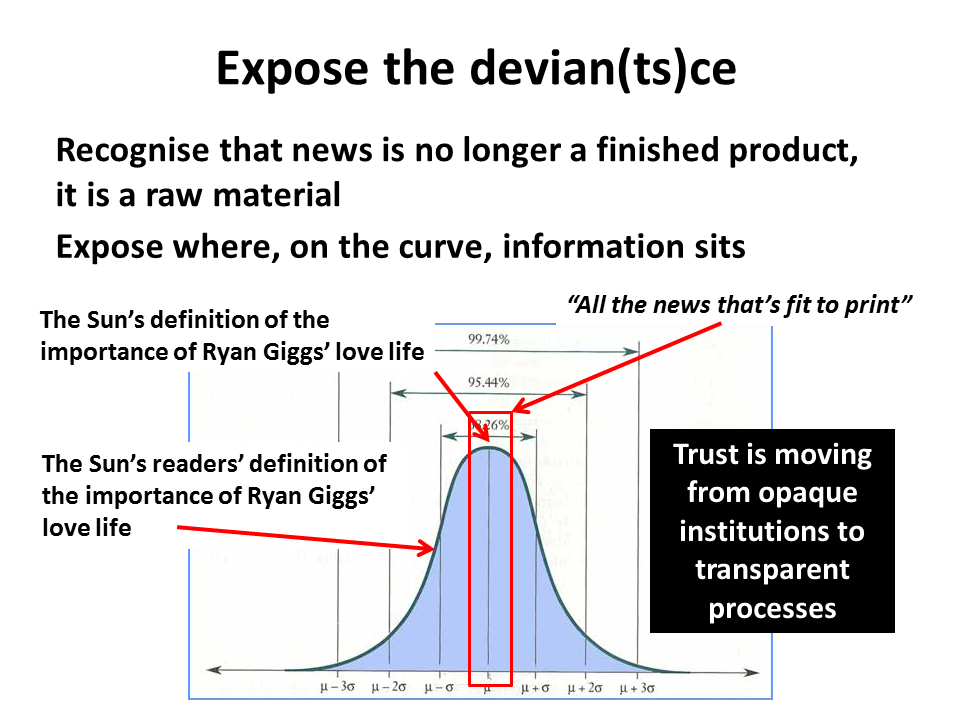Truth in Twitterland
Here is a very interesting article by Alan Patrick. It compares the Google and the Twitter windows on a current news story and proposes that the view through the Twitter window is actually more nuanced and investigative than the rather one-dimensional, or populist, view provided by Google.
This certainly chimes with my own experience. Some while back I compared the Twitter versus tabloid media view, in relation to the Ryan Giggs / super injunction fiasco in the UK in 2011. The conclusion I reached here was that the Twitter view was, again, much more nuanced and far less sensationalist than the view the tabloid press traditionally put out in these sort of cases. Most people were really not that interested in Ryan Giggs love life, certainly not to the extent which might justify front page spreads. Which is probably why many tabloid journalists are so scornful of ‘the people on Twitter’, because Twitter deflates the tabloids’ ability to titilate.
There is a further, more recent example. Last year the BBC and its Newsnight programme got into a huge amount of hot water over the ‘naming’ of a former Tory politician, Lord McAlpine, as a paedophile at the centre of a child abuse ring. Lord McAlpine is not a paedophile and while the BBC did not actually name him, it was inferred that his name was the one that was heading a list names that were ‘circulating on the internet’ – primarily Twitter. McAlpine himself then went on to instigate legal proceeding against some of those people on Twitter deemed responsible. This just goes to show how fundamentally untrustworthy and downright evil this whole Twitter-website-internet thing is – one might have thought.
Except – as this story was brewing I went and had a look ‘at Twitter’ to see exactly what was going on. Now whilst Lord McAlpine’s name certainly came up, along with a whole list of other, frequently ludicrous, suggestions – there was another name which was much more firmly linked to much more specific allegations. If one had looked at Twitter in the whole, you would not have reached the conclusion that Lord McAlpine was the prime suspect in this case. I was thus astonished to see the BBC allowing McAlpine’s name to enter the frame on the basis that this was already out there on Twitter, because while some individual tweets may have been suggesting this, a consideration of the collective view of Twitter would have led one to a very different conclusion. (I shall not name who Twitter saw as the prime suspect for obvious reasons).
Thus – the BBC effectively inferred that Lord McAlpine was the suspect – and got it wrong. And the evil untrustworthy Twitter may not have got it right (we shall never know the truth because the powers that be have dropped this subject like a hot potato), but it didn’t get it as wrong as the BBC did.
The main point, from all of this, is that news in the social digital space, cannot be defined in an institutional way any more. News is becoming a raw material, not a finished product and the distillation of what is truth is shifting from institutions into processes. You can’t understand Twitter as an institution, you can only understand it as a process. Twitter (unlike Newsnight) was not purporting to tell me that something was true or not true – it simply provided me with a process that allowed me to make my own conclusions. And key to this process working effectively is transparency and the ability to put information in context. It is what I call the ability to see the whole probability curve of news and where upon it, any individual bit of information sits.
And going back to Alan Patrick’s article, Twitter is much better placed to deliver against this than Google – certainly when it comes to news – because it doesn’t attempt to attach a score to a particular piece of information in order to rank it (or define its truthfulness). Instead it allows you to see the spread of opinion and apply a probability approach. Google’s strength is in other areas, where seeing the curve is less important. Thus Google is good at answering question such as ‘when to prune raspberries?’ whereas Twitter is better at answering questions such as ‘is this news story really true?’

